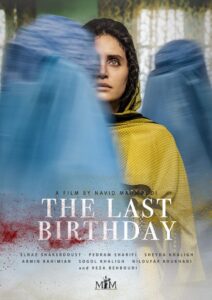Throughout the history of world cinema, the sound of fists pounding on doors has always signified something terrible. When it is accompanied by the sounds of rapid gunfire, our hearts quicken and our breathing is suspended. That is how THE LAST BIRTHDAY opens as we see a woman rushing about her apartment gathering and burning photos and documents while anxiously awaiting the invasion of her home.
On August 13, 2021, thirteen days before this tense opening scene, the same woman is happily preparing for her birthday party. Various friends and loved ones arrive to celebrate the occasion. They include Leili, a young student living with Soraya; Fahim, Soraya’s loving partner; Sanam, an actress whose first film will premiere that evening, and other Afghans, all young enough to have primarily experienced the hopeful time after the Taliban lost control over the country.
But cell phone calls, Facebook videos, Tweets, and TV announcements eventually change the positive mood of the party into apprehension and uncertainty as news arrives about the fall of Herat into Taliban hands once again. Still, that city is over 500 miles away from Kabul by road, so all does not appear to be lost. Within days that delusion dissipates as gunfire erupts in Kabul, President Ashraf Ghani boards a plane bound for his escape to the U.A.E., and other friends arrive at Soraya’s apartment on their way out of their beloved homeland.
Each one brings rumors, fears, and news that the Taliban, already in Kabul, are entering homes in search of anyone who has “helped the enemy” or who simply has ignored the once prevalent Taliban rules about women’s roles. Soraya’s former job as a journalist and Sanam’s acting career endanger both of them. Sanam encapsulates the impending reality: “Future, women, cinema, big screen – it’s all ruined.”
 Flight seems to be the only solution to survival, but stories about the crowds at the airport and along border exit points put such escape routes in doubt. An ISIS-sponsored suicide bombing reportedly kills over 200 people at the airport. Even getting to the airport is in question with the Taliban stopping cars and interrogating people obviously in flight.
Flight seems to be the only solution to survival, but stories about the crowds at the airport and along border exit points put such escape routes in doubt. An ISIS-sponsored suicide bombing reportedly kills over 200 people at the airport. Even getting to the airport is in question with the Taliban stopping cars and interrogating people obviously in flight.
But all that is seen and heard by us through TV, computer, and phone screens. The camera never looks outside except for quick glimpses through parted curtains on the windows of the spacious apartment. Instead, Iranian cinematographer Mehran Mamdooh remains inside the various rooms and effortlessly moves from place to place, face to face, conversation to conversation. What might seem claustrophobic is actually the only freedom momentarily possible within the ever-tightening circle of armed Taliban. But when the burqa descends over Soraya’s face, we see things through that fundamentalist filter, the impending viewpoint of all women in the Afghanistan once again returning to the shadows of Taliban rule.
The soundtrack has joyful music at the beginning, but as the days pass and darken, the sound of airplanes overhead signifies flight away from the homeland, desperation, and potential death or imprisonment.
The film ends with the same scene as the beginning one but expands as Soraya provides an unforgettable note of strength and defiance when she returns to her profession as the “Burga-Wearer Reporter.” This time she is not receiving news through her cellphone but creating a final newscast herself with an anguished, but powerful proclamation “We, the youth of Afghanistan, had high hopes and dreams for our future. We had plans to make life more enjoyable for us and our countrymen. We were happy thinking that the Americans were standing with us to make a better world. Trump and Biden sold us so cheap. We are now the loneliest people in the world. I am Soraya Azad.”
Writer/director Navid Mahmoudi’s gripping film is, of necessity in 2023, is an indepently produced film with truly remarkable Iranian actors. Elnaz Shakerdoost is especially outstanding as Soraya. Pedram Sharifi as Fahim is strong, calm, and reassuring. Sheida Khaligh has the most heart-rending role of Leila, whose fiancé’s execution destroys her hopes for future happiness. As over four decades of Iranian cinema have proven, Iran’s actors and directors are among the finest in the world.

